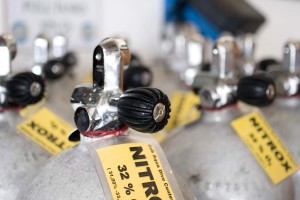Since French chemist Antoine Laurent Lavoisier discovered and named oxygen in 1777, we’ve learned a lot about it. Oxygen is the third-most common element in the known universe and is obviously vital for life. In recreational diving, we use more-concentrated oxygen mixes to help circumnavigate some of the laws of physics that govern recreational diving on traditional compressed air cylinders. One of those workarounds is the advent of nitrox diving.
What is nitrox?

As you read this, you’re breathing air, which is approximately 21 percent oxygen. The remainder, approximately 79 percent (leaving aside approximately 1 percent in trace gases), is nitrogen.
A nitrox, EANX or Enriched Air cylinder — depending on your location — has an increased oxygen percentage inside. Usually, we define nitrox as having an oxygen content of greater than 21 percent and up to a maximum of 40 percent.
As a gas, we have used nitrox for several decades. Commercial-diving companies and the Navy have used it since the 1950s. When it first appeared in a recreational environment, however, some divers viewed nitrox with skepticism. Nevertheless, its popularity has grown exponentially in tandem with the use of personal dive computers. Now, on most dive boats and at most resorts, nitrox is the gas of choice. Divers largely choose nitrox as their default gas for most dives in the 60-foot (18m) to 130-foot (40 m) range, where it’s most effective.
Why use it?
Divers primarily choose nitrox to extend their bottom time. You may recall learning during training that two factors primarily govern your bottom time; first, your gas consumption (or ‘SAC’ rate). Second, particularly as you progress beyond open-water diver (60 foot/18 m) recommendations, is your no-stop or no-decompression time. These two factors form the basis of your turn points when planning and executing a dive.
Your no-decompression limit is the maximum amount of time you may spend at a given depth before making mandatory decompression stops during ascent. The defining factor in when you reach that time is the amount of nitrogen you’ve absorbed while under pressure.
For example, using a standard PADI/DSAT dive table, a dive to 70 feet (21 m) gives a no-decompression limit as 40 minutes with no previous dives.
By replacing some of the nitrogen in your cylinder with oxygen and increasing the overall oxygen blend in your cylinder to 32 percent, you can extend your no-decompression time limit to 60 minutes.
Does that mean all my dives will be longer?
No. Your own gas consumption — your ‘SAC rate’ — will still factor into the dive, as will all the many other factors that govern duration and depth. Your buddy, water temperature, logistical constraints, tides, dive boat/site rules — all play a role.
Are there any other benefits?
Diving is statistically very safe and, therefore, using nitrox doesn’t mean that, statistically, you’re any safer. However, diving an identical profile to an air diver you will absorb less nitrogen and therefore have less DCS risk exposure. Indeed, many divers dive an air profile while using nitrox for extra conservatism.
Another benefit of reduced nitrogen exposure on each dive is that surface intervals may be shorter. This means that in some circumstances, you may be able to get back in the water while your air counterparts must spend more time on the boat.
Can I dive deeper on nitrox?
No. This is a common misconception. The increased oxygen content in a nitrox cylinder does have certain considerations though. Over-exposure to oxygen – either in terms of exceeding depth limits or long-term over-exposure — can have serious implications. In these circumstances, you can suffer from oxygen toxicity. You must obtain proper training to understand how to manage these risks and ensure nitrox diving is extremely safe.
Are there any other hazards?
Knowing exactly what is in your cylinder, personally analyzing your cylinder and planning your dive accordingly is key to nitrox diving. Each individual mix from 22 to 40 percent has a maximum-operating depth (MOD). Consequently, the mix you use will depend on the dive you’re about to do, your previous dives and the length of your surface interval. Using the wrong cylinder or an incorrect mix may have dire consequences. In some circumstances, a boat crew will prepare different a different mix of gas in different cylinders depending on diver and dive-site requirements.
How would I identify a nitrox dive cylinder?

In many territories, nitrox cylinders have green and yellow markings and are marked with EANX/nitrox decals. However, in other locations, there are no markings on the tank. As a rule, when boarding a dive boat or arriving at a dive center, wait until they’ve given you a prepared nitrox cylinder. Usually all is revealed during the boat or dive briefing.
Do I need special equipment to dive with nitrox?
Most diving equipment is compatible with an oxygen content of up to 40 percent. Beyond that, the combustibility of oxygen often necessitates more specialized equipment.
Is nitrox training intensive?
No. Most larger diver training agencies offer a recreational nitrox course that you can complete over just a few hours. Usually it includes a combination of e-learning, classroom teaching and practical application with nitrox cylinders. It’s vital that divers using nitrox understand how to plan and execute their dives including MOD, no-stop limits and how to recognize and deal with oxygen toxicity. Understanding the benefits and the hazards of nitrox diving is key, and no reputable dive operation would supply you with nitrox cylinders without evidence of the correct training and certification.
Who should use nitrox?
There are circumstances when you may not need nitrox, such as shorter or shallower dives. However, in general, it’s a boon to most divers. Whether you’re repetitive diving on a tropical dive holiday or want to safely spend a few extra minutes on your favorite cold-water wreck, nitrox can pay dividends. With the correct knowledge and training, nitrox diving is a huge benefit and we recommend it to all.

